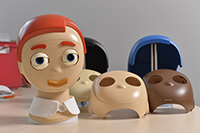© Universität Bielefeld
uni.news
Published on
5. Juni 2015
Category
General
Robotic Modelling for Kids with Bielefeld Robot Flobi
Robotics research at CITEC featured in June issue of Geolino extra
Robots are the topic of the new issue of the children’s magazine GEOlino extra, which came out on 3 June 2015. In the article titled “Flobi learns to feel,” reporter Katharina von Ruschkowski profiles the research of Bielefeld University computer science professor Britta Wrede. The article focuses on the robotic head, Flobi, which researchers at CITEC are using to investigate the issue of how robots should ideally look and behave in order to be accepted by humans. So as to help young readers learn how scientific research works, the issue also includes a cut-out activity sheet that allows them to model different facial expressions on a paper model Flobi and see how people react to him.
 The GEO team spent an entire day at CITEC visiting Flobi and became well acquainted with CITEC’s research robot. They played a game of memory with him and got to experience how it feels to lose to a robot. The team photographed him in different hair colors and hair lengths and observed how his facial expressions changed with these alterations to his appearance. Britta Wrede and Andreas Kipp discussed with the GEOlino team how Flobi is being used in current research, along with plans for future research.
The GEO team spent an entire day at CITEC visiting Flobi and became well acquainted with CITEC’s research robot. They played a game of memory with him and got to experience how it feels to lose to a robot. The team photographed him in different hair colors and hair lengths and observed how his facial expressions changed with these alterations to his appearance. Britta Wrede and Andreas Kipp discussed with the GEOlino team how Flobi is being used in current research, along with plans for future research.
Flobi is a robotic head with a round face and big blue eyes. He can portray different facial expressions with his mouth and his eyebrows. Standing at just 30 centimeters tall, Flobi speaks both German and English. Scientists at the Cluster of Excellence Cognitive Interaction Technology (CITEC) developed the research prototypes in order to analyze what factors are important in communication between humans and robots. They are also investigating how a robotic head must be designed in order to facilitate simple and natural interaction.
GEOlino extra is published six times per year and is geared towards young readers 8–14 years old. In contrast to the monthly GEOlino magazine, each approximately 100-page issue of GEOlino extra is devoted to a different topic. These special issues are accompanied by various supplements, such as games or cut-out activity sheets specifically designed for the issue. These supplements give the young readers a playful and creative introduction to the topic. GEOlino extra can be purchased at kiosks and newsagents for seven Euro.
On GEOlino’s website (www.geolino.de/flobi) readers can also download different-colored hairpieces and eyebrows on the website for the Flobi cut-out activity sheet.
More information is available online at:
www.geolino.de/flobi
Contact:
Professor Dr.-Ing. Britta Wrede, Cluster of Excellence Cognitive Interaction Technology, Bielefeld University.
Telephone: +49 521 106-2953
Email: bwrede@techfak.uni-bielefeld.de
Robots are the topic of the new issue of the children’s magazine GEOlino extra, which came out on 3 June 2015. In the article titled “Flobi learns to feel,” reporter Katharina von Ruschkowski profiles the research of Bielefeld University computer science professor Britta Wrede. The article focuses on the robotic head, Flobi, which researchers at CITEC are using to investigate the issue of how robots should ideally look and behave in order to be accepted by humans. So as to help young readers learn how scientific research works, the issue also includes a cut-out activity sheet that allows them to model different facial expressions on a paper model Flobi and see how people react to him.
Flobi, the robotic head, pictured here wearing orange hair, can be oufitted with different hair pieces and faces. Photo: CITEC
Flobi is a robotic head with a round face and big blue eyes. He can portray different facial expressions with his mouth and his eyebrows. Standing at just 30 centimeters tall, Flobi speaks both German and English. Scientists at the Cluster of Excellence Cognitive Interaction Technology (CITEC) developed the research prototypes in order to analyze what factors are important in communication between humans and robots. They are also investigating how a robotic head must be designed in order to facilitate simple and natural interaction.
GEOlino extra is published six times per year and is geared towards young readers 8–14 years old. In contrast to the monthly GEOlino magazine, each approximately 100-page issue of GEOlino extra is devoted to a different topic. These special issues are accompanied by various supplements, such as games or cut-out activity sheets specifically designed for the issue. These supplements give the young readers a playful and creative introduction to the topic. GEOlino extra can be purchased at kiosks and newsagents for seven Euro.
On GEOlino’s website (www.geolino.de/flobi) readers can also download different-colored hairpieces and eyebrows on the website for the Flobi cut-out activity sheet.
More information is available online at:
www.geolino.de/flobi
Contact:
Professor Dr.-Ing. Britta Wrede, Cluster of Excellence Cognitive Interaction Technology, Bielefeld University.
Telephone: +49 521 106-2953
Email: bwrede@techfak.uni-bielefeld.de